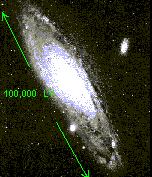 The sun is one of several hundred billion stars in our galaxy. The galaxy is a collection of stars that stretches through space a distance of 100,000 light-years.  A light-year is the distance that light travels in one year, or about 10 trillion kilometres. Thus the length of the galaxy is about 1,000,000,000,000,000,000 kilometers. Only the brightest stars can be seen in this picture; billions of others are too faint to be seen...as is our sun, which is represented here by the flashing yellow dot, about two-thirds of the way out from the center. The average distance between stars throughout most of the galaxy is many light-years...or tens of trillions of kilometres. If you were travelling at 20 kilometres a second, which is about as fast as any spacecraft we've ever built, it would take almost 70,000 years to reach the star nearest to the sun, and about 1.5 billion years to travel the length of the galaxy. Here's an analogy that might help you visualize stellar distances. Suppose the sun were an orange. On this scale, Earth would be a grain of sand 8 metres away. Pluto, the most distant planet in our solar system, would be a smaller grain of sand 300 metres from the orange. The nearest star would be another orange, 2000 kilometres away! Our galaxy? Picture a vast collection of oranges...250 billion of them... stretching out for 60 million kilometres! Our galaxy is quite ordinary, and is one of many hundreds of billions of galaxies in the visible universe. |